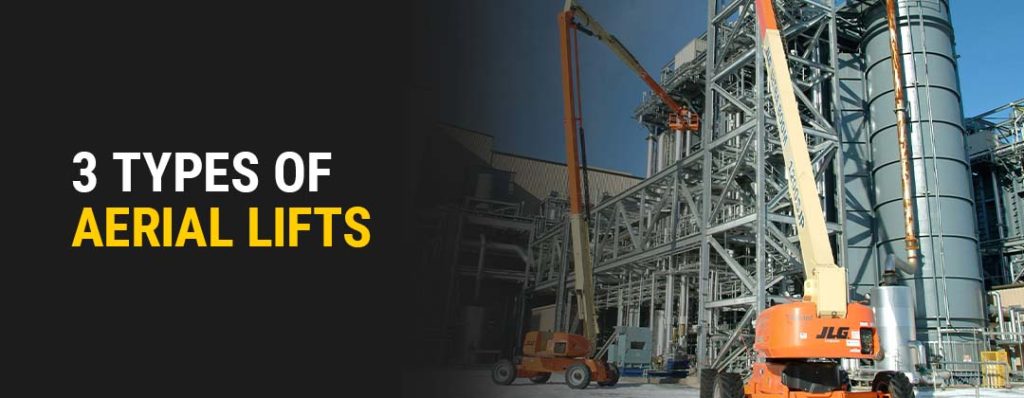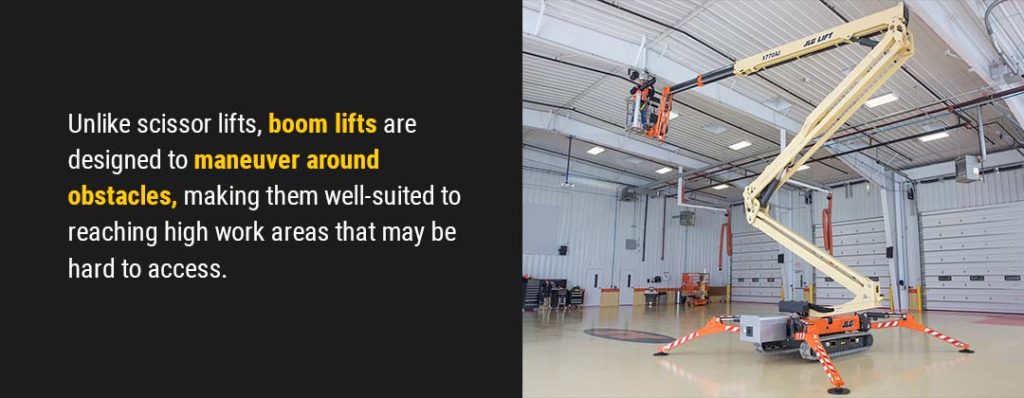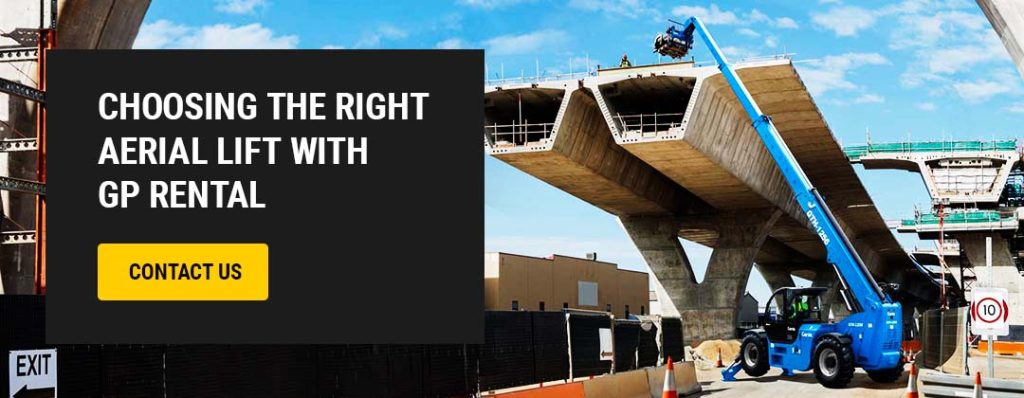
Reaching high work areas safely is an essential element of many industries. Creating aerial work platforms for your crew can help you complete jobs safely and on time. To do so, you need an aerial lift. There are three main types of aerial lift equipment – scissor lifts, boom lifts and telehandlers. Each lift type has unique features that make it well-suited for different operations.
An aerial lift is a machine that raises workers and materials to high or hard-to-reach places, offering a safer and more efficient option than ladders or scaffolding. The type of aerial lift you choose will depend on various factors, including the load capacity you need, the kind of work site and what the aerial lift will be used for.
Scissor lifts are hydraulic platforms designed to lift heavy loads and workers vertically. Some scissor lift models have deck extensions that allow for minor horizontal reach, but the weight capacity is often limited. The height capacity of a scissor lift can range from 15 to 50 feet.
Many businesses are investing in scissor lifts as they have a similar function to scaffolding and ladders with a more reliable reach and carrying capacity. Scissor lifts mainly raise workers to high work areas, so they are also called personnel lifts. There are two main types of scissor lifts — electric and rough terrain.
Also known as electric slab scissor lifts, this lift is best suited for inside jobs or smaller-scale work sites. This is because they have non-marking tires that work best on smooth or paved surfaces and a narrow width that allows them to enter small spaces. They also have a tighter turning radius, making them a popular option in warehouses as they can navigate narrow aisles and sharp corners.
Electric scissors lifts are powered by batteries that can usually last the full length of a shift. Depending on the model, electric scissor lifts can have a load capacity of over a thousand pounds.
Rough terrain scissors lifts are designed to travel over rough terrain. They serve the same purpose as electric scissor lifts, except they have tires well-suited for rugged external conditions. Some models will have four-wheel options, outriggers, pothole protection and other systems to make them more stable and effective in rough terrain.
The way rough terrain lifts are powered is also different. Instead of batteries, they use diesel, hybrid power or dual fuel. The emissions from these scissor lifts mean they are unsuitable for work in confined or poorly ventilated areas — however, fuel is preferable for outdoor environments because wet conditions can harm electric components.

Boom lifts are what most people talk about when it comes to aerial lifts. They are also known as cherry pickers, man lifts, basket cranes or bucket lifts and are the most popular personnel lifts businesses use. Boom lifts comprise a hydraulic lift system that powers a crane and a platform or bucket. Unlike scissor lifts, boom lifts are designed to maneuver around obstacles, making them well-suited to reaching high work areas that may be hard to access.
Firefighters, landscapers, electricians, window cleaners and builders often use boom lifts. You can choose between internal combustion-powered or electric boom lifts. There are three main types of boom lifts — straight, articulated and towable.
Also called straight telescopic booms, these boom lifts have limited maneuverability. A work platform is attached to a telescopic extension arm with no hinges. The lack of hinges means straight booms can only move up, down or forward. Telescopic boom lifts are suited to work requiring one person and are often used by electricians and landscapers.
Articulated or knuckle boom lifts are better known as cherry pickers. The lift arm is attached to a turntable which allows it to rotate. The arm has hinges or “knuckles”, making it possible to bend and maneuver the arm around obstacles. The flexibility of the articulating boom means it can be used indoors and outdoors, especially if obstacles limit access.
Towable boom lifts are the most portable option for boom lifts. They are articulated boom lifts that can be mounted to pickup trucks or trailers to be transported between sites. The additional portability of this boom lift makes it a flexible option that can be used for tree trimming, restoration protections, electrical work, window washing and more.
Towable booms have a shorter reach than other boom lifts, but the portability of these machines often makes up for the limitations in reach.
Telehandlers are rough terrain aerial lifts. They are similar to telescopic booms and forklifts with fitted lifting attachments and reach higher than forklifts. Typically, telehandlers have a four-wheel chassis with a telescopic boom attached.
Different lifting attachments are available for telehandlers, making them precise and flexible aerial lifts. Telehandlers are highly durable, and they are ideal for outside work such as agriculture and construction as they can handle rough terrains, carry heavy loads and access hard-to-reach areas.
The two types of telehandlers popular for use on construction sites, farms and other industries include telescopic and rotating.
Telescopic or fixed telehandlers have a fixed cab and a telescopic boom that only goes up and down or in and out. They are the most popular of the two types of telehandlers. They are well-suited to moving equipment and materials across sites and are typically used on farms or construction sites.
As the name suggests, rotating telehandlers are capable of swiveling a full 360 degrees. The machine’s body remains stationary while the lift and operator cab move around. This allows operators a wider range of motion. The dynamic range of movement makes rotating telehandlers ideal for moving loads in tight spaces and are typically used on construction sites or industrial yards.
As they are designed to offer a broader range of movement, their height and load capacities are lower than telescopic telehandlers.

Whether you are a landscaper or work in construction, you are bound to need an aerial lift for your operations. The type of aerial lift you choose will be based on several factors including size restrictions, weight capacity required, the maximum height and even the power source of the aerial lift. GP Rental supplies a wide range of aerial lifts for rental and sale. Our professional team will help you find the right aerial lift for your operation.
Contact us today or visit one of our locations to find your perfect fit!